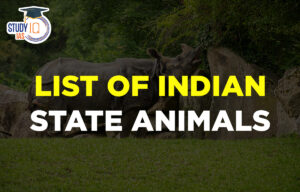Table of Contents
Context: The recently published ‘IPCC’s AR6 Synthesis Report’ suggested that preventing degradation of existing ecosystems more effective than afforestation in mitigating climate change.
Background: India’s Pursuit Towards Afforestation
- India’s NDCs: As part of the NDCs (Nationally Determined Contributions) to the UNFCCC, India has committed to adding “an additional (cumulative) carbon sink of 2.5-3 GtCO2e through additional forest and tree cover by 2030”.
- Compensatory afforestation: Afforestation is also codified in the Compensatory Afforestation Fund Management and Planning Authority (CAMPA), a body chaired by the Environment Minister.
- National Forest Policy (1988): It has recommended 33 percent forest cover for the plains and 67 percent for the hills.
- Afforestation and Reforestation Programmes in India
- National Mission for a Green India: It is one of the eight Missions under the National Action Plan on Climate Change (NAPCC). It aims at protecting, restoring and enhancing India’s forest cover and responding to Climate Change.
- National Afforestation Programme (NAP) Scheme: The objective of this scheme is ecological restoration of degraded forests and to develop the forest resources with peoples’ participation, with focus on improvement in livelihoods of the forest-fringe communities, especially the poor.
What did the IPCC’s Synthesis Report say about Afforestation?
- Criticism: The report has criticized afforestation because it can lead to the destruction of natural ecosystems in one area while attempting to create new ones in distant locations.
- Natural ecosystems are more effective: Natural ecosystems are vital as they sequester more carbon and provide important biodiversity, hydrological services, and local livelihoods.
- Focus on renewable energy: The report suggests that renewable energy, particularly solar power, has more potential for mitigating climate change than afforestation.
- However, renewable energy projects such as solar parks and wind farms can cause conflicts with local communities and may have negative impacts on ecosystems.

What is Compensatory Afforestation?
- Compensatory afforestation means that every time forest land is diverted for non-forest purposes such as mining or industry, the user agency pays for planting forests over an equal area of non-forest land, or when such land is not available, twice the area of degraded forest land.
- In India, compensatory afforestation is mandated by the Forest (Conservation) Act, 1980.
The Compensatory Afforestation Fund (CAF) Act, 2016
- Purpose: The CAF Act was enacted to manage the funds collected for compensatory afforestation which till then was managed by ad hoc Compensatory Afforestation Fund Management and Planning Authority (CAMPA).
- Adhoc CAMPA was established following the Supreme Court’s Order (T.N. Godavarman Thirumulpad Vs Union of India case) in 2006 to manage the Compensatory Afforestation Fund (CAF).
- National and State Funds: The Act established a National Compensatory Afforestation Fund under the Public Account of India and State Compensatory Afforestation Fund under the Public Account of each state.
- The payments made for compensatory afforestation, net present value and others related to the project will be deposited in the fund.
- Net Present Value: The Act acknowledged the fact that newly afforested land cannot be expected to immediately start delivering the range of goods and services like timber, bamboo, fuelwood, carbon sequestration, soil conservation, water recharge, and seed dispersal that the diverted forests were providing.
- As a result, project developers are also asked to pay for the Net Present Value (NPV) of the forests being cleared based on a calculation decided by an expert committee.
- Distribution: The State Funds will receive 90% of the payments while National Fund will receive remaining 10%.
- Use of Funds: The funds can be used for the treatment of catchment areas, assisted natural generation, forest management, wildlife protection and management, relocation of villages from protected areas, managing human-wildlife conflicts, training and awareness generation, supply of wood saving devices, and allied activities.
Problems with Compensatory Afforestation
- Greenwashing: According to some experts, compensatory afforestation has legitimized clearing of forests, and see it as an example of ‘greenwashing’.
- Greenwashing is when a company purports to be environmentally conscious for marketing purposes but isn’t making any notable sustainability efforts.
- Low Utilization of Funds: The money collected for compensatory afforestation before 2016 has remained largely unutilized. Serious work on compensatory afforestation has begun only after the 2016 Act.
- No Availability of Land: Lack of availability of suitable land remains the biggest problem for compensatory afforestation.
- The land that is made available for afforestation usually cannot be used for any other purpose and is often extremely unsuitable for growing plantations.
- Monoculture Plantations: Often the plantations are monocultures, meaning they contain only one species of plants. There is a lack of biodiversity.
- Reductive View of Forests: According to some experts, the concept of compensatory afforestation works for the benefit of the biggest polluters of the planet.
- Projects that consume good forests can engage states or private entities to undertake paid plantations in distant regions despite no compatibility in terms of the qualities of what is lost and what is to be recreated.
- Parliamentary Standing Committee on Science and Technology, Environment and Forests (PSC) Report: According to the report, CAF Act 2016 has no time frame for creating compensatory forests, and is highly bureaucratic in operations.


 Daily Quiz 17 April 2025
Daily Quiz 17 April 2025
 Nilgiri Biosphere Reserve, Map, Climate,...
Nilgiri Biosphere Reserve, Map, Climate,...
 Complete List of Indian State Animals
Complete List of Indian State Animals





















